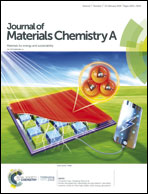Poly(ionic liquid)–zinc polyoxometalate composite as a binder-free cathode for high-performance lithium–sulfur batteries†
Abstract
The development of the most promising next-generation Li–S batteries with high utilization of sulfur while retaining high capacity is one of the great challenges of the 21st century. Here, we reported sandwich polyoxometalate [WZn3(H2O)2(ZnW9O34)2]12− (ZnPOM) over a poly(1-vinyl-3(2-(2-methoxyethoxy)ethyl)imidazolium) cation (PVIMo) matrix as a binder-free cathode catalyst for a high-capacity LiS battery with a high areal loading of 7.68 mg cm−2 and high areal capacity of 11.14 mA h cm−2 (70% sulfur). The synergistic effect between PVIMo and ZnPOM resulted in outstanding initial discharge capacity of 1450 mA h g−1 at 0.5 C with high capacity retention (97%), high coulombic efficiency (>98%) and a negligible capacity fading rate of 0.02% per cycle at an electrolyte/sulfur ratio of 10 μL(E) mg(S)−1 and capacity fading of only 0.02% per cycle. The cationic polymer PVIMo held the negatively charged polysulfide ions at the cathode and ZnPOM facilitated the conversion of polysulfides to sulfur. Quantitative estimation by EQCM, UV-Vis analysis and potentiometric titration demonstrated negligible loss of sulfur even after 120 cycles of the charge–discharge process.



 Please wait while we load your content...
Please wait while we load your content...